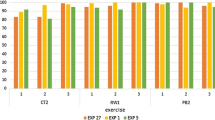Abstract
Background
Increasing usage of robotic surgery presents surgeons with the question of how to acquire the special skills required. This study aimed to analyze the effect of different exercises on their performance outcomes.
Methods
This prospective study was conducted on the da Vinci Skills Simulator from December 2014 till August 2015. Sixty robotic novices were included and randomized to three groups of 20 participants each. Each group performed three different exercises with comparable difficulty levels. The exercises were performed three times in a row within two training sessions, with an interval of 1 week in between. On the final training day, two new exercises were added and a questionnaire was completed. Technical metrics of performance (overall score, time to complete, economy of motion, instrument collisions, excessive instrument force, instruments out of view, master work space range, drops, missed targets, misapplied energy time, blood loss and broken vessels) were recorded by the simulator software for further analysis.
Results
Training with different exercises led to comparable results in performance metrics for the final exercises among the three groups. A significant skills gain was recorded between the first and last exercises, with improved performance in overall score, time to complete and economy of motion for all exercises in all three groups.
Conclusions
As training with different exercises led to comparable results in robotic training, the type of exercise seems to play a minor role in the outcome. For a robotic training curriculum, it might be important to choose exercises with comparable difficulty levels. In addition, it seems to be advantageous to limit the duration of the training to maintain the concentration throughout the entire session.



Similar content being viewed by others
References
Intuitive Surgical. Investor relations http://investor.intuitivesurgical.com/phoenix.zhtml?c=122359&p=irol-irhome
Bernstein Leibhard LLP. da Vinci robot lawsuit information center. www.davincirobotlawsuitcase.com
Moglia A, Ferrari V, Morelli L, Ferrari M, Mosca F, Cuschieri A (2015) A systematic review of virtual reality simulators for robot-assisted surgery. Eur Urol. doi:10.1016/j.eururo.2015.09.021
Gallagher AG, O’Sullivan GC (2011) Fundamentals of surgical simulation. Springer, Berlin
Alzahrani THR, Alkhayal A, Delisle J, Drudi L, Gotlieb W, Fraser S, Bergman S, Bladou F, Andonian S, Anidjar M (2013) Validation of the da Vinci Surgical Skill Simulator across three surgical disciplines: a pilot study. Can Urol Assoc J 7:e520–e529
Abboudi H, Khan MS, Aboumarzouk O, Guru KA, Challacombe B, Dasgupta P, Ahmed K (2013) Current status of validation for robotic surgery simulators—a systematic review. BJU Int 111:194–205
Hung AJ, Jayaratna IS, Teruya K, Desai MM, Gill IS, Goh AC (2013) Comparative assessment of three standardized robotic surgery training methods. BJU Int 112:864–871
Hung AJ, Zehnder P, Patil MB, Cai J, Ng CK, Aron M, Gill IS, Desai MM (2011) Face, content and construct validity of a novel robotic surgery simulator. Urology 186:1019–1024
Lee JY, Mucksavage P, Kerbl DC, Huynh VB, Etafy M, McDougall EM (2012) Validation study of a virtual reality robotic simulator—role as an assessment tool? J Urol 187:998–1002
Liss MA, Abdelshehid C, Quach S, Lusch A, Graversen J, Landman J, McDougall EM (2012) Validation, correlation, and comparison of the da Vinci trainer and the da Vinci surgical skills simulator using the Mimic software for urologic robotic surgical education. J Endourol 26:1629–1634
Ramos P, Montez J, Tripp A, Ng CK, Gill IS, Hung AJ (2014) Face, content, construct and concurrent validity of dry laboratory exercises for robotic training using a global assessment tool. BJU Int 113:836–842
Gomez PP, Willis RE, van Sickle KR (2015) Development of a virtual reality robotic surgical curriculum using the da Vinci Si surgical system. Surg Endosc 29(8):2171–2179
Calatayud D, Arora S, Aggarwal R, Kruglikova I, Schulze S, Funch-Jensen P, Grantcharov T (2010) Warm-up in a virtual reality environment improves performance in the operating room. Ann Surg 251(6):1181–1185
Kahol K, Satava RM, Ferrara J, Smith ML (2009) Effect of short-term pretrial practice on surgical proficiency in simulated environments: a randomized trial of the “preoperative warm-up” effect. J Am Coll Surg 208(2):255–268
Sheth SS, Fader AN, Tergas AI, Kushnir CL, Green IC (2014) Virtual reality robotic surgical simulation: an analysis of gynecology trainees. J Surg Educ 71:125–132
Walliczek U, Förtsch A, Dworschak P, Teymoortash A, Mandapathil M, Werner J, Güldner C (2015) Effect of training frequency on the learning curve on the da Vinci Skills Simulator. Head Neck. doi:10.1002/hed.24312 [Epub ahead of print], Dec 17, 2015
Lyons C, Goldfarb D, Jones SL, Badhiwala N, Miles B, Link R, Dunkin BJ (2013) Which skills really matter? Proving face, content, and construct validity for a commercial robotic simulator. Surg Endosc 27:2020–2030
Patel A, Patel M, Lytle N, Toro JP, Medbery RL, Bluestein S, Perez SD, Sweeney JF, Davis SS, Lin E (2014) Can we become better robot surgeons through simulator practice? Surg Endosc 28:847–853
Tergas AI, Sheth SB, Green IC, Giuntoli RL 2nd, Winder AD, Fader AN (2013) A pilot study of surgical training using a virtual robotic surgery simulator. JSLS 17(2):219–226
Author information
Authors and Affiliations
Corresponding author
Ethics declarations
Disclosures
Drs. Ute Walliczek-Dworschak, Marie Schmitt, Philipp Otto Georg Dworschak, Isabel Diogo, Anja Ecke, Magis Mandapathil, Afshin Teymoortash and Christian Güldner have no conflicts of interest or financial ties to disclose.
Electronic supplementary material
Below is the link to the electronic supplementary material.
Rights and permissions
About this article
Cite this article
Walliczek-Dworschak, U., Schmitt, M., Dworschak, P. et al. The effect of different training exercises on the performance outcome on the da Vinci Skills Simulator. Surg Endosc 31, 2397–2405 (2017). https://doi.org/10.1007/s00464-016-5240-z
Received:
Accepted:
Published:
Issue Date:
DOI: https://doi.org/10.1007/s00464-016-5240-z




